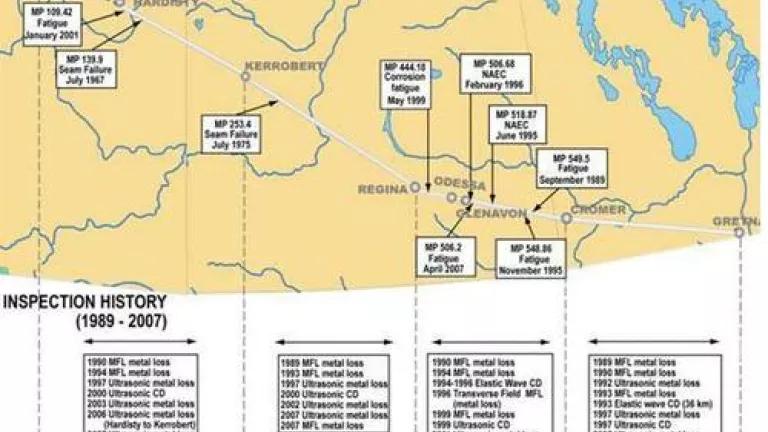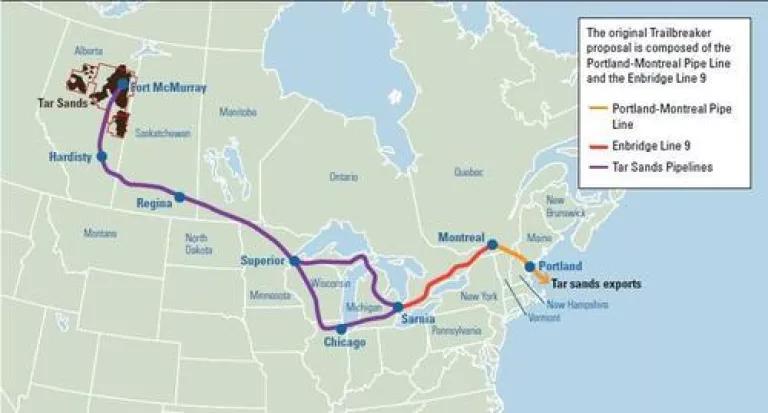
The National Transportation Safety Board’s (NTSB) searing indictment of Enbridge has implications that go well beyond that controversial Canadian pipeline company’s responsibility for the $800 million Kalamazoo River tar sands spill. Investigators found that Enbridge’s missteps constituted “an organizational accident,” or the result of multiple errors which have often been commitment by the Canadian pipeline company. In addition to citing a prevalence of recurring poor safety practices throughout Enbridge’s organization, investigators found that the Kalamazoo spill manifested errors observed in previous Enbridge accidents that the company has failed to learn from. NTSB Chairman Deborah Hersman has likened Enbridge’s systematic poor performance to the Keystone Kops for its systematic poor performance – an alarming prospect given that Enbridge is proposing to build half a dozen new tar sands pipelines in highly sensitive regions of Canada and the United States.
“It’s evident that this accident did not just occur because of corrosion in a pipeline. What this investigation has shown is that this accident was the result of corrosion throughout many vital safety aspects of the Enbridge organization.” Robert Sumwalt, NTSB Board Member
Enbridge’s failures are even more striking when put in context with the company’s many other spills, painting a picture of a company systematically incapable of learning from its past mistakes. A 2007 government investigation of a similar spill in the Canadian section of Enbridge’s pipeline paints a picture of a company unable to learn from its past mistakes. On a single pipeline, the Canadian report shows nine spills due to stress corrosion cracking and metal fatigue from cyclic stress on seam welds – the same problems that Enbridge ignored for five years on Line 6B before it ruptured and spilled into the Kalamazoo River.
Figure 1: Enbridge’s Canadian pipeline: A 2008 government investigation of Enbridge’s pipeline paints the picture of a pipeline unable to learn from its spills.
Enbridge now claims that Line 6B is safe and that it’s taken appropriate actions to deal with its safety lapses. This would be more convincing if Enbridge hadn’t previously claimed to have appropriately dealt with many of the same issues years ago. Following Canada’s Transportation Safety Board’s investigation in 2008, Enbridge claimed that it was establishing a more conservative model for allowable crack depth from inline inspection data, modifying its crack repair criteria, changing its field inspection and repair activities and improving pressure cycle monitoring activities.
NTSB’s findings following the Kalamazoo tar sands spill suggest that Enbridge’s announced changes were superficial at best. Investigators found that Enbridge ignored the interaction of corrosion and stress cracking, despite the fact that these problems had caused numerous spills on the company’s tar sands pipeline system. According to NTSB's presentation, the company also used an inadequate safety margin for stress corrosion cracking on its pipeline, raising questions about the “more conservative model for allowable crack depth” announced by the company in 2008. Moreover, Enbridge continued to ignore cracks on Line 6B for years after announcing changes to its crack repair criteria. Given the lack of response to a known problem, it is not surprising that Enbridge has been responsible for over 160 accidents in the last decade in the United States alone, spiling millions of gallons of crude.
“There have been a lot of opportunities for Enbridge to learn lessons over the years that stem from, specifically, accident investigations here in the U.S. and in Canada, and what we saw in this accident investigation was that they had not learned those lessons well.” Deborah Hersman, NTSB Chairman
In addition to Enbridge’s poor record of operating pipelines, some of the company’s most recent construction projects in the United States have been characterized by accidents and sloppy practices. During the construction a pipeline through Wisconsin, Enbridge spilled 176,000 gallons of crude, contaminating the local water supply. Ultimately, Enbridge paid $1.1 million to settle a lawsuit brought against it by the state of Wisconsin for 545 environmental violations in the construction of that pipeline.
“Enbridge’s] incidents of violation were numerous and widespread, and resulted in impacts to the streams and wetlands throughout the various watersheds.” Wisconsin Attorney General J.B. Van Hollen, 2009, regarding Enbridge’s pipeline construction in Wisconsin
These findings put Enbridge’s ambitious pipeline expansion plans in a new light. Enbridge is asking the public to double down on a company with a demonstrated record of sloppy construction practices, pipeline failures and botched cleanup efforts. Government regulators, permitting bodies and the general public should seriously consider whether they want a company like Enbridge building high capacity tar sands pipelines across thousands of miles of sensitive waterways throughout the United States and Canada. Here are just a couple of major proposals that Enbridge is pushing:
Northern Gateway: Enbridge has proposed to build this controversial pipeline to move more than half a million barrels of tar sands through Alberta and British Columbia over 1,000 kilometers of mountainous terrain, salmon rivers, coastal rainforests, and sensitive marine waters. Many Canadians recognize the problems with this project – the proposed route for Northern Gateway crosses many remote but sensitive regions where spills would be potentially catastrophic. First Nations along the pipeline route have vigorously opposed this tar sands pipeline and the majority of British Columbians oppose the project. Opposition to the project has intensified following NTSB’s scathing report showing Enbridge as a repeated bad actor. British Columbia’s Premier Christy Clark recently condemned Enbridge for its handling of Kalamazoo – adding yet another nail in the coffin of this troubled proposal.
“I think the company should be deeply embarrassed about what unfolded, we saw that in the report. If they think they’re going to operate like that in British Columbia – forget it.” Christy Clark, British Columbia Premier

Trailbreaker Pipeline: Enbridge is simultaneously proposing a major expansion of its ailing Lakehead pipeline system to move tar sands across Canada, the Midwest and New England. This means an expansion of many of Enbridge’s pipelines, including the section of its pipeline which led to the Kalamazoo tar sands spill. Allowing Enbridge, an operator with a demonstrated record of preventable catastrophic pipeline failures, to move greater volumes of more hazardous tar sands on an already spill prone system the definition of a bad idea.

Enbridge hasn’t proven capable of safely constructing, maintaining or operating its existing pipeline infrastructure. Rewarding a company with a history of spills, poor safety programs and an inability to adhere to minimum safety standards with higher capacity and more hazardous tar sands pipelines gives the pipeline industry the wrong message – that pipeline safety is a matter of public relations rather than critical component of business operations.

